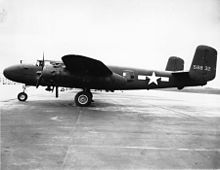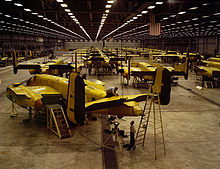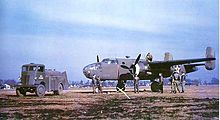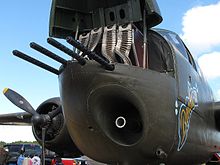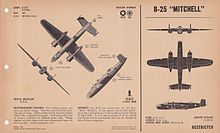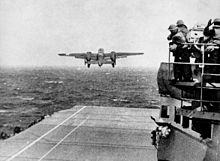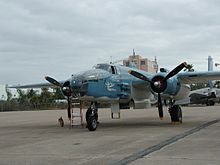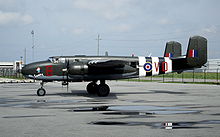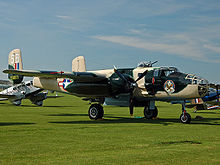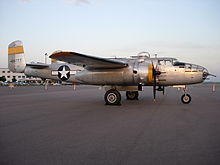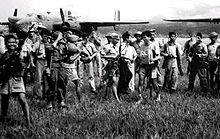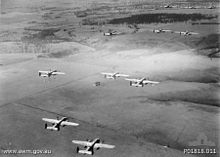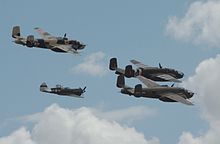- North American B-25 Mitchell
-
"B-25" redirects here. For British World War II-era fighter plane, see Blackburn Roc.
B-25 Mitchell A B-25C Mitchell in 1942 Role Medium bomber Manufacturer North American Aviation First flight 19 August 1940 Introduction 1941 Retired 1979 (Indonesia) Primary users United States Army Air Forces
Royal Canadian Air Force
Royal Air Force
Soviet Air ForceNumber built 9,984 Developed from XB-21 Developed into North American XB-28 The North American B-25 Mitchell was an American twin-engined medium bomber manufactured by North American Aviation. It was used by many Allied air forces, in every theater of World War II, as well as many other air forces after the war ended, and saw service across four decades.
The B-25 was named in honor of General Billy Mitchell, a pioneer of U.S. military aviation. By the end of its production, nearly 10,000 B-25s in numerous models had been built. These included a few limited variations, such as the United States Navy's and Marine Corps' PBJ-1 patrol bomber and the United States Army Air Forces' F-10 photo reconnaissance aircraft.
Contents
Design and development
The B-25 was a descendant of the earlier XB-21 (North American-39) project of the mid-1930s. Experience gained in developing that aircraft was eventually used by North American in designing the B-25 (called the NA-40 by the company). One NA-40 was built, with several modifications later being done to test a number of potential improvements. These improvements included Wright R-2600 radial engines, which would become standard on the later B-25.
In 1939, the modified and improved NA-40B was submitted to the United States Army Air Corps for evaluation. This aircraft was originally intended to be an attack bomber for export to the United Kingdom and France, both of which had a pressing requirement for such aircraft in the early stages of World War II. However, those countries changed their minds, opting instead for the also-new Douglas DB-7 (later to be used by the US as the A-20 Havoc). Despite this loss of sales, the NA-40B re-entered the spotlight when the Army Air Corps evaluated it for use as a medium bomber. Unfortunately, the NA-40B was destroyed in a crash on 11 April 1939. Nonetheless, the type was ordered into production, along with the Army's other new medium bomber, the Martin B-26 Marauder.
Early production
An improvement of the NA-40B, dubbed the NA-62, was the basis for the first actual B-25. Due to the pressing need for medium bombers by the Army, no experimental or service-test versions were built. Any necessary modifications were made during production runs, or to existing aircraft at field modification centers around the world.
A significant change in the early days of B-25 production was a re-design of the wing. In the first nine aircraft, a constant-dihedral wing was used, in which the wing had a consistent, straight, slight upward angle from the fuselage to the wing tip. This design caused stability problems, and as a result, the dihedral angle was nullified on the outboard wing sections, giving the B-25 its slightly gull wing configuration. Less noticeable changes during this period included an increase in the size of the tail fins and a decrease in their inward cant.
A total of 6,608 B-25s were built at North American's Fairfax Airport plant in Kansas City, Kansas.
A descendant of the B-25 was the North American XB-28, meant to be a high-altitude version of the B-25. Despite this premise, the actual aircraft bore little resemblance to the Mitchell. It had much more in common with the Martin B-26 Marauder.
Operational history
 Doolittle Raid B-25Bs aboard USS Hornet
Doolittle Raid B-25Bs aboard USS Hornet
Far East
The majority of B-25s in American service were used in the Pacific. It fought on Papua New Guinea, in Burma and in the island hopping campaign in the central Pacific. It was in the Pacific that the aircraft’s potential as a ground attack aircraft was discovered and developed. The jungle environment reduced the usefulness of standard level bombing, and made low level attack the best tactic. The ever-increasing amount of forward firing guns was a response to this, making the B-25 a formidable strafing aircraft.
In Burma the B-25 was often used to attack Japanese communication links, especially bridges in central Burma. It was also used to help supply the besieged troops at Imphal in 1944.
In the Pacific the B-25 proved itself to be a very capable anti-shipping weapon, sinking many of the ships being used to reinforce the Japanese position. Later in the Pacific war the distance between islands limited the usefulness of the B-25, although it was used against Guam and Tinian. It was also used against Japanese-occupied islands that had been bypassed by the main campaign, as happened in the Marshal Islands.
Middle East and Italy
The first B-25s arrived in Egypt just in time to take part in the battle of El Alamein. From there the aircraft took part in the rest of the campaign in North Africa, the invasion of Sicily and the advance up Italy. In Italy the B-25 was used in the ground attack role, concentrating on attacks against road and rail links in Italy, Austria and the Balkans. The B-25 had a longer range than the Douglas A-20 Havoc and Douglas A-26 Invaders, allowing it to reach further into occupied Europe. The five bombardment groups that used the B-25 in the desert and Italy were the only U.S. units to use the B-25 in Europe.
Europe
The U.S. Eighth Air Force, based in Britain, concentrated on long range raids over Germany and occupied Europe. Although it did have a small number units equipped with twin-engined aircraft, the B-25 was not amongst them. However, the RAF received nearly 900 Mitchells, using them to replace Douglas Bostons, Lockheed Venturas and Vickers Wellington bombers. The Mitchell entered active RAF service on 22 January 1943. At first it was used to bomb strategic targets in occupied Europe. After the D-Day invasion the RAF used its Mitchells to support the armies in Europe, moving several squadrons to forward airbases in France and Belgium.
Operators
USAAF
 B-25 of 13th Squadron, 3rd Bomb Group, on low-level "skip-bombing" mission in New Guinea
B-25 of 13th Squadron, 3rd Bomb Group, on low-level "skip-bombing" mission in New Guinea
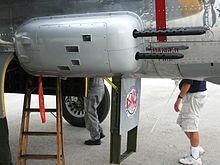 Closeup of an early model B-25 gun pod
Closeup of an early model B-25 gun pod
The B-25 first gained fame as the bomber used in the 18 April 1942 Doolittle Raid, in which 16 B-25Bs led by the legendary Lieutenant Colonel Jimmy Doolittle attacked mainland Japan, four months after the bombing of Pearl Harbor. The mission gave a much-needed lift in spirits to the Americans, and alarmed the Japanese who had believed their home islands were inviolable by enemy troops. While the amount of actual damage done was relatively minor, it forced the Japanese to divert troops for the home defense for the remainder of the war. The raiders took off from the carrier USS Hornet and successfully bombed Tokyo and four other Japanese cities without loss. However, 15 subsequently crash-landed en route to recovery fields in Eastern China. These losses were the result of the task force being spotted by a Japanese vessel forcing the bombers to take off 170 mi (270 km) early, fuel exhaustion, stormy nighttime conditions with zero visibility, and lack of electronic homing aids at the recovery bases. Only one landed intact; it came down in the Soviet Union, where its five-man crew was interned and the aircraft confiscated. Of the 80 aircrew, 69 survived their historic mission and eventually made it back to American lines.
Following a number of additional modifications, including the addition of Plexiglas windows for the navigator and radio operator, heavier nose armament, and deicing and anti-icing equipment, the B-25C was released to the Army. This was the second mass-produced version of the Mitchell, the first being the lightly armed B-25B used by the Doolittle Raiders. The B-25C and B-25D differed only in location of manufacture: -Cs at Inglewood, California, -Ds at Kansas City, Kansas. A total of 3,915 B-25Cs and -Ds were built by North American during World War II.
Although the B-25 was originally designed to bomb from medium altitudes in level flight, it was used frequently in the Southwest Pacific theater (SWPA) on treetop-level strafing and parafrag (parachute-retarded fragmentation bombs) missions against Japanese airfields in New Guinea and the Philippines. These heavily armed Mitchells, field-modified at Townsville, Australia, by Major Paul I. "Pappy" Gunn and North American tech rep Jack Fox, were also used on strafing and skip-bombing missions against Japanese shipping trying to re-supply their land-based armies. Under the leadership of Lieutenant General George C. Kenney, B-25s of the Fifth and Thirteenth Air Forces devastated Japanese targets in the SWPA from 1942 to 1945, and played a significant role in pushing the Japanese back to their home islands. B-25s were also used with devastating effect in the Central Pacific, Alaska, North Africa, Mediterranean and China-Burma-India (CBI) theaters.
Use as a gunship
Because of the urgent need for hard-hitting strafer aircraft, a version dubbed the B-25G was developed, in which the standard-length transparent nose and the bombardier were replaced by a shorter solid nose containing two fixed .50 in (12.7 mm) machine guns and a 75 mm (2.95 in) M4 cannon, one of the largest weapons fitted to an aircraft, similar to the experimental British Mosquito Mk. XVIII, and German Ju 88P heavy cannon carrying aircraft. The cannon was manually loaded and serviced by the navigator, who was able to perform these operations without leaving his crew station just behind the pilot. This was possible due to the shorter nose of the G-model and the length of the M4, which allowed the breech to extend into the navigator's compartment.
The B-25G's successor, the B-25H, had even more firepower. The M4 gun was replaced by the lighter T13E1, designed specifically for the aircraft. The 75 mm (2.95 in) gun fired at a muzzle velocity of 2,362 ft/s (about 720 m/s). Due to its low rate of fire (approximately four rounds could be fired in a single strafing run) and relative ineffectiveness against ground targets, as well as substantial recoil, the 75 mm (2.95 in) gun was sometimes removed from both G and H models and replaced with two additional .50 in (12.7 mm) machine guns as a field modification.[1] The -H also mounted four fixed forward-firing .50 (12.7 mm) machine guns in the nose, four more fixed ones in forward-firing cheek blisters, two more in the top turret, one each in a pair of new waist positions, and a final pair in a new tail gunner's position. Company promotional material bragged the B-25H could "bring to bear 10 machine guns coming and four going, in addition to the 75 mm cannon, a brace of eight rockets and 3,000 lb (1,360 kg) of bombs."[2]
The B-25H also featured a redesigned cockpit area, with the top turret moved forward to the navigator's compartment (thus requiring the addition of the waist and tail gun positions), and a heavily modified cockpit designed to be operated by a single pilot, the co-pilot's station and controls deleted, and the seat cut down and used by the navigator/cannoneer, the radio operator being moved to the aft compartment, operating the waist guns.[3] A total of 1,400 B-25Gs and B-25Hs were built.
The final version of the Mitchell, the B-25J, looked much like the earlier B, C and D, having reverted to the longer nose. The less-than-successful 75 mm (2.95 in) cannon was deleted on the J model. Instead, 800 of this version were built with a solid nose containing eight .50 (12.7 mm) machine guns, while other J-models featured the earlier "greenhouse" style nose containing the bombardier's position. Regardless of the nose style used, all J-models also included two .50 in (12.7 mm) guns in a "fuselage package" located directly under the pilot's station, and two more such guns in an identical package just under the co-pilot's compartment. The solid-nose B-25J variant carried an impressive total of 18 .50 in (12.7 mm) guns: eight in the nose, four in under-cockpit packages, two in an upper turret, two in the waist, and a pair in the tail. No other bomber of World War II carried as many guns. However, the first 555 B-25Js (the B-25J-1-NC production block) were delivered without the fuselage package guns, because it was discovered muzzle blast from these guns was causing severe stress in the fuselage; this was cured with heavier fuselage skin patches, while later production runs returned these guns, they were often removed as a field modification for the same reason.[4] In all, 4,318 B-25Js were built.
Flight characteristics
The B-25 was a safe and forgiving aircraft to fly. With an engine out, 60° banking turns into the dead engine were possible, and control could be easily maintained down to 145 mph (230 km/h). However, the pilot had to remember to maintain engine-out directional control at low speeds after take off with rudder; if this was attempted with ailerons, the aircraft would snap out of control. The tricycle landing gear made for excellent visibility while taxiing. The only significant complaint about the B-25 was the extremely high noise level produced by its engines; as a result, many pilots eventually suffered from various degrees of hearing loss.[5] The high noise level was due to design and space restrictions in the engine cowlings which resulted in the exhaust "stacks" protruding directly from the cowling ring and partly covered by a small triangular fairing. This directed exhaust and noise directly at the pilot and crew compartments. Crew members and operators on the airshow circuit frequently comment that "the B-25 is the fastest way to turn aviation fuel directly into noise". Many B-25s now in civilian ownership have been modified with exhaust rings that direct the exhaust through the outboard bottom section of the cowling.
The Mitchell was also an amazingly sturdy aircraft and could withstand tremendous punishment. One well-known B-25C of the 321st Bomb Group was nicknamed "Patches" because its crew chief painted all the aircraft's flak hole patches with high-visibility zinc chromate paint. By the end of the war, this aircraft had completed over 300 missions, was belly-landed six times and sported over 400 patched holes. The airframe was so bent, straight-and-level flight required 8° of left aileron trim and 6° of right rudder, causing the aircraft to "crab" sideways across the sky.[citation needed]
An interesting characteristic of the B-25 was its ability to extend range by using one-quarter wing flap settings. Since the aircraft normally cruised in a slightly nose-high attitude, about 40 gal (150 l) of fuel was below the fuel pickup point and thus unavailable for use. The flaps-down setting gave the aircraft a more level flight attitude, which resulted in this fuel becoming available, thus slightly extending the aircraft's range.[5]
By the time a separate United States Air Force was established in 1947, most B-25s had been consigned to long-term storage. However, a select number continued in service through the late 1940s and 1950s in a variety of training, reconnaissance and support roles. Its principal use during this period was for undergraduate training of multi-engine aircraft pilots slated for reciprocating engine or turboprop cargo, aerial refueling or reconnaissance aircraft. Still others were assigned to units of the Air National Guard in training roles in support of Northrop F-89 Scorpion and Lockheed F-94 Starfire operations. TB-25J-25-NC Mitchell, 44-30854, the last B-25 in the USAF inventory, assigned at March AFB, California as of March 1960,[6] was flown to Eglin AFB, Florida, from Turner Air Force Base, Georgia, on 21 May 1960, the last flight by a USAF B-25, and presented by Brig. Gen. A. J. Russell, Commander of SAC's 822d Air Division at Turner AFB, to the Air Proving Ground Center Commander, Brig. Gen. Robert H. Warren, who in turn presented the bomber to Valparaiso, Florida Mayor Randall Roberts on behalf of the Niceville-Valparaiso Chamber of Commerce. Four of the original Tokyo Raiders were present for the ceremony, Col. Davy Jones, Col. Jack Simms, Lt. Col. Joseph Manske, and retired Master Sgt. Edwin W. Horton.[7] It was donated back to the Air Force Armament Museum circa 1974 and marked as Doolittle's 40-2344.[8]
Today, many B-25s are kept in airworthy condition by air museums and collectors.
The PBJ-1 was a navalized version of the USAAF B-25. It had its origin in a deal cut in mid-1942 between the Navy and the USAAF. As part of the deal, 50 B-25Cs and 152 B-25Ds were transferred to the Navy from the USAAF. The bombers carried Navy serial numbers beginning with 34998. The first PBJ-1s arrived in February 1943. They were used by Marine Corps pilots, beginning with VMB-413. Many of them were equipped with a search radar with a retractable radome fitted in place of the ventral turret.
Large numbers of B-25H and J variants were delivered to the Navy as PBJ-1H and PBJ-1J respectively. These aircraft joined, but did not necessarily replace, the earlier PBJs.
The PBJs were operated almost exclusively by the Marine Corps as land-based bombers. To operate them, the US Marine Corps established a number of bomber squadrons, beginning with VMB-413, in March 1943 at Cherry Point, North Carolina. Eight VMB squadrons were flying PBJs by the end of 1943, forming the initial Marine Medium Bombardment Group. Four more squadrons were in the process of formation in late 1945, but had not yet deployed by the time the war ended.
Operational use of the Marine Corps PBJ-1s began in March 1944. The Marine PBJs operated from the Philippines, Saipan, Iwo Jima and Okinawa during the last few months of the Pacific war. Their primary mission was the long range interdiction of enemy shipping that was trying to run the blockade which was strangling Japan. The weapon of choice during these missions was usually the five-inch HVAR rocket, eight of which could be carried on underwing racks. Many of the PBJ-1C and D versions carried a rather ugly, bulbous antenna for an APS-3 search radar sticking out of the upper part of the transparent nose. On the PBJ-1H and J, the APS-3 search radar antenna was usually housed inside a ventral or wingtip radome. Some PBJ-1Js had their top turrets removed to save weight, especially toward the end of the war when Japanese fighters had become relatively scarce.
Royal Air Force
The Royal Air Force (RAF) was an early customer for the B-25 via Lend-Lease. The RAF was the only force to use the B-25 on raids against Europe from bases in the United Kingdom, as the USAAF used the Martin B-26 Marauder for this purpose instead.
The first Mitchells were designated Mitchell I by the RAF and were delivered in August 1941, to No 111 Operational Training Unit based in the Bahamas. These bombers were used exclusively for training and familiarization and never achieved operational status. The B-25Cs and Ds were designated Mitchell II, altogether, 167 B-25Cs and 371 B-25Ds were delivered to the RAF.
A total of 93 Mitchell Is and IIs had been delivered to the RAF by the end of 1942 and served with No. 2 Group, the RAF's tactical medium bomber force. The first RAF operation with the Mitchell II took place on 22 January 1943, when six aircraft attacked oil installations at Ghent. After the invasion of Europe, all four Mitchell squadrons moved to bases in France to support Allied ground forces. The British Mitchell squadrons were joined by No. 342 (Lorraine) Squadron of the French Air Force in April 1945.
No 305 (Polish) Squadron flew Mitchell IIs from September to December 1943 before transitioning to Mosquitos. In addition to the 2nd Group, the B-25 was used by various second-line RAF units in the UK and abroad. In the Far East, No. 3 PRU, which consisted of Nos. 681 and 684 Squadrons, flew the Mitchell (primarily Mk IIs) on photographic reconnaissance sorties.
The RAF was allocated 316 B-25Js as Mitchell IIIs. Deliveries took place between August 1944 and August 1945. However, only about 240 of these bombers actually reached Britain, with some being diverted to No. 111 OTU in the Bahamas, some crashing during delivery and some being retained in the USA.
Royal Canadian Air Force
The Royal Canadian Air Force (RCAF) was an important user of the B-25 Mitchell, although most of the RCAF use of the Mitchell was postwar. The first B-25s for the RCAF had originally been diverted to Canada from RAF orders. These included one Mitchell I, 42 Mitchell IIs, and 19 Mitchell IIIs. No 13 (P) Squadron was formed unofficially at Rockcliffe in May 1944. They operated Mitchell IIs on high altitude aerial photography sorties. They retained the Mitchell until October 1948.
No 418 (Auxiliary) Squadron received its first Mitchell IIs in January 1947. It was followed by No 406 (auxiliary) which flew Mitchell IIIs from April 1947 to June 1958. No 418 Operated a mix of IIs and IIIs until March 1958. No 12 Squadron of Air Transport Command also flew Mitchell IIIs along with other types from September 1956 to November 1960. In 1951, the RCAF received an additional 75 B-25Js from USAF stocks to make good attrition and to equip various second-line units.
Royal Australian Air Force
It was not until the spring of 1944 that the Australians were to get Mitchells. By the spring of 1944, No. 18 Squadron had more than enough Mitchells than which could be used by just one squadron, and could spare a few. Arrangements were made to re-equip the RAAF's No. 2 Squadron with these extra aircraft, replacing their Beauforts.
Dutch Air Force
During the World War II, the Mitchell served in fairly large numbers with the Air Force of the Dutch government-in-exile. They participated in combat both in the East Indies as well as on the European front. On 30 June 1941, the Netherlands Purchasing Commission, acting on behalf of the Dutch government in exile in London, signed contract with North American Aviation for 162 B-25C aircraft. The bombers were to be delivered to the Netherlands East Indies to help deter any Japanese aggression into the region.
In February 1942, the British Overseas Airways Corporation (BOAC) agreed to ferry 20 of the Dutch B-25s from Florida to Australia via Africa and India, and an additional 10 via the South Pacific route from California. During March, five of the bombers on the Dutch order had reached Bangalore, India and 12 had reached Archerfield in Australia. It was agreed that the B-25s in Australia would be used as the nucleus of a new squadron, designated No. 18. This squadron would be staffed jointly by Australian and Dutch aircrews plus a smattering of aircrews from other nations, but would operate at least initially under Royal Australian Air Force command. However, the B-25s of No. 18 Squadron would be painted with the Dutch national insignia (at this time a rectangular Netherlands flag) and would carry NEIAF serials. Discounting the 10 "temporary" B-25s delivered to 18 Squadron in early 1942, a total of 150 Mitchells were taken on strength by the NEIAF, 19 in 1942, 16 in 1943, 87 in 1944, and 28 in 1945. They flew bombing raids against Japanese targets in the East Indies. In 1944, the more capable B-25J Mitchell replaced most of the earlier C and D models.
In June 1940, No 320 Squadron of the Royal Air Force had been formed from personnel formerly serving with the Royal Dutch Naval Air Service who had escaped to England after the German occupation of the Netherlands. Equipped with various British aircraft, No. 320 Squadron flew anti-submarine patrols, convoy escort missions, and performed air-sea rescue duties. They acquired the Mitchell II in September 1943, performing operations over Europe against gun emplacements, railway yards, bridges, troops and other tactical targets. They moved to Belgium in October 1944, and transitioned to the Mitchell III in 1945. No. 320 Squadron was disbanded in August 1945. Following the war, B-25s were used in a vain attempt of the Dutch to retain control of Indonesia.
Soviet Air Force
The US supplied 862 B-25 aircraft to the Soviet Union under Lend-Lease during the Second World War.
Other damaged aircraft arrived or crashed in the Far East of Russia, and one Doolittle Raid aircraft landed there short of fuel after attacking Japan. It is not known what happened to these latter aircraft.
China Air Force
Well over 100 B-25Cs and Ds were supplied to the Nationalist Chinese during the Second World War. In addition, a total of 131 B-25Js were supplied to China under Lend-Lease.
The four squadrons of the 1st BG (1st, 2nd, 3rd, and 4th) of the 1st Medium Bomber Group were formed during the War. They formerly operated Russian-built Tupolev SB bombers, then transferred to the B-25. The 1st BG was under the command of CACW (Chinese-American Composite Wing) while operating B-25. Following the end of the war in the Pacific, these four bombardment squadrons were established to fight against the Communist insurgency that was rapidly spreading throughout the country. During the civil war, Chinese Mitchells fought alongside de Havilland Mosquitos.
In December 1948, the Nationalists were forced to move to the island of Taiwan, taking many of their Mitchells with them. However, some B-25s were left behind and were impressed into service with the air force of the new People's Republic of China.
Brazilian Air Force
During the war, the Força Aérea Brasileira (FAB) received a few B-25s under Lend-Lease. Brazil declared war against the Axis powers in August 1942 and participated in the war against the U-boats in the southern Atlantic. The last Brazilian B-25 was finally declared surplus in 1970.
Free French
At least 21 Mitchell IIIs were issued by the Royal Air Force to No 342 Squadron, which was made up primarily of Free French aircrews.
Following the liberation of France, this squadron was transferred to the newly formed French air force (Armee de l'Air) as GB I/20 Lorraine. These aircraft were operated by GB I/20 after the war, some being converted from bomber configuration into fast VIP transports. They were finally struck off charge in June 1947.
Empire State Building incident
Main article: B-25 Empire State Building crashOn Saturday, 28 July 1945, at 0940 (while flying in thick fog), a USAAF B-25D crashed into the north side of the Empire State Building, hitting between the 79th and 80th floor. 14 people were killed — 11 in the building, along with Colonel William Smith and the other two occupants of the bomber.[9] Betty Lou Oliver, an elevator attendant, survived the impact and a subsequent uncontrolled descent with the elevator. It was partly because of this incident that Towers 1 and 2 of the World Trade Center were designed to withstand the impact of a Boeing 707 aircraft (although the aircraft that hit the towers on 9/11 had significantly higher masses and were traveling at substantially higher speeds).[10]
Variants
- B-25
- The first version of the B-25 delivered. No prototypes were ordered. The first nine aircraft were built with constant dihedral angle. Due to low stability, the wing was redesigned so that the dihedral was eliminated on the outboard section. (Number made: 24.)
- B-25A
- Version of the B-25 modified to make it combat ready; additions included self-sealing fuel tanks, crew armor, and an improved tail gunner station. No changes were made in the armament. Re-designated obsolete (RB-25A designation) in 1942. (Number made: 40.)
- B-25B
- Rear turret deleted; manned dorsal and remotely-operated ventral turrets added, each with a pair of .50 in (12.7 mm) machine guns. The ventral turret was retractable, but the increased drag still reduced the cruise speed by 30 mph (48 km/h). 23 were delivered to the RAF as the Mitchell Mk I. The Doolittle Raiders flew B-25Bs on their famous mission. (Number made: 120.)
- B-25C
- Improved version of the B-25B: powerplants upgraded from Wright R-2600-9 radials to R-2600-13s; de-icing and anti-icing equipment added; the navigator received a sighting blister; nose armament was increased to two .50 in (12.7 mm) machine guns, one fixed and one flexible. The B-25C model was the first mass-produced B-25 version; it was also used in the United Kingdom (as the Mitchell II), in Canada, China, the Netherlands, and the Soviet Union. First mass-produced B-25 model. (Number made: 1,625.)
- ZB-25C
- B-25D
- Identical to the B-25C, the only difference was that the B-25D was made in Kansas City, Kansas, whereas the B-25C was made in Inglewood, California. First flew on 3 January 1942. (Number made: 2,290.)
- WB-25D
- In 1944, four B-25Ds were converted for weather reconnaissance by the 53d Weather Reconnaissance Squadron. originally called the Army Hurricane Reconnaissance Unit, now called the "Hurricane Hunters". Weather recon first started in 1943 with the First Weather Reconnaissance Squadron, with flights on the North Atlantic ferry routes.[11][12]
- ZB-25D
- XB-25E
- Single B-25C modified to test de-icing and anti-icing equipment that circulated exhaust from the engines in chambers in the leading and trailing edges and empennage. The aircraft was tested for almost two years, beginning in 1942; while the system proved extremely effective, no production models were built that used it prior to the end of World War II. Many prop aircraft today use the XB-25E system. (Number made: 1, converted.)
- ZXB-25E
- XB-25F-A
- Modified B-25C that tested the use of insulated electrical de-icing coils mounted inside the wing and empennage leading edges as a de-icing system. The hot air de-icing system tested on the XB-25E was more practical. (Number made: 1, converted.)
- XB-25G
- Modified B-25C in which the transparent nose was replaced by a solid one carrying two fixed .50 in (12.7 mm) machine guns and a 75 mm (2.95 in) M4 cannon, then the largest weapon ever carried on an American bomber. (Number made: 1, converted.)
- B-25G
- To satisfy the dire need for ground-attack and strafing aircraft, the B-25G was made following the success of the prototype XB-25G. The production model featured increased armor and a greater fuel supply than the XB-25G. One B-25G was passed to the British, who gave it the name Mitchell II that had been used for the B-25C. (Number made: 420.)
- B-25H
 B-25H Barbie III taxiing at Centennial Airport, Colorado
B-25H Barbie III taxiing at Centennial Airport, Colorado
- An improved version of the B-25G. It featured two additional fixed .50 in (12.7 mm) machine guns in the nose and four in fuselage-mounted pods; the heavy M4 cannon was replaced by a lighter 75 mm (2.95 in) T13E1. (Number made: 1,000; number left flying in the world: 1.)
- B-25J
- The last production model of the B-25, often called a cross between the B-25C and the B-25H. It had a transparent nose, but many of the delivered aircraft were modified to have a solid nose. Most of its 14–18 machine guns were forward-facing for strafing missions. The RAF received 316 aircraft, which were known as the Mitchell III. (Number made: 4,318.)
- CB-25J
- Utility transport version.
- VB-25J
- A number of B-25s were converted for use as staff and VIP transports. Henry H. Arnold and Dwight D. Eisenhower both used converted B-25Js as their personal transports.
Trainer variants
Most models of the B-25 were used at some point as training aircraft.
- TB-25D
- Originally designated AT-24A (Advanced Trainer, Model 24, Version A). Trainer modification of B-25D. In total, 60 AT-24s were built.
- TB-25G
- Originally designated AT-24B. Trainer modification of B-25G.
- TB-25C
- Originally designated AT-24C. Trainer modification of B-25C.
- TB-25J
- Originally designated AT-24D. Trainer modification of B-25J. Another 600 B-25Js were modified after the war.
- TB-25K
- Hughes E1 fire-control radar trainer (Hughes). (Number made: 117.)
- TB-25L
- Hayes pilot-trainer conversion. (Number made: 90.)
- TB-25M
- Hughes E5 fire-control radar trainer. (Number made: 40.)
- TB-25N
- Hayes navigator-trainer conversion. (Number made: 47.)
- PBJ-1C
- Similar to the B-25C for the US Navy; often fitted with airborne search radar and used in the anti-submarine role.
- PBJ-1D
- Similar to the B-25D for the US Navy and US Marine Corps. Differed in having a single .50 in (12.7 mm) machine gun in the tail turret and beam gun positions similar to the B-25H. Often fitted with airborne search radar and used in the anti-submarine role.
- PBJ-1G
- US Navy/US Marine Corps designation for the B-25G
- PBJ-1H
- US Navy/US Marine Corps designation for the B-25H
- PBJ-1J
- US Navy designation for the B-25J-NC (Blocks -1 through -35) with improvements in radio and other equipment. Often fitted with "package guns" and wingtip search radar for the anti-shipping/anti-submarine role.
- One PBJ-1H was modified with carrier take-off and landing equipment and successfully tested on the USS Shangri-La, but the Navy did not continue development.
Operators
- Biafran Air Force operated two aircraft.
- Brazilian Air Force (75 units B-25B,B-25C,B-25J)
- Royal Canadian Air Force - bomber, light transport, training aircraft, "special" mission roles
- 13 Squadron (Mitchell II)
- People's Liberation Army Air Force operated captured Nationalist Chinese aircraft.
- Indonesian Air Force received some B-25 Mitchells from Netherlands, the last example retired in 1979.
- Mexican Air Force received three B-25Js in December 1945, which remained in use until at least 1950.[13]
- Eight Mexican civil registrations were allocated to B-25s, including one aircraft registered to the Bank of Mexico but used by the President of Mexico.[14]
- Royal Netherlands Air Force
- Dutch Naval Aviation Service
- Royal Netherlands East Indies Army Air Force - Postwar
- Peruvian Aeronautical Corps (CAP) received 8 B-25Js in 1947, which formed Bomber Squadron N° 21 at Talara.
- Spanish Air Force former USAAF serial number 41-30338 interned in 1944 and operated between 1948 and 1956.[15]
- Soviet Air Force (Voyenno-Vozdushnye Sily or VVS) received a total of 866 B-25s (of types C/D/S/G/J).[16]
- Royal Air Force received more than 900 aircraft.
- see B-25 Mitchell units of the United States Army Air Forces
Survivors
North American B-25J (with invasion_stripes) of the Canadian Warplane Heritage Museum during the Brantford Air Show at the Brantford Airport, Brantford, Ontario, Canada Main article: List of surviving B-25 Mitchells
Main article: List of surviving B-25 MitchellsThere are more than one hundred surviving B-25 Mitchells scattered over the world, mainly in the United States. Most of them are on static display in museums, but about 45 are still airworthy.
A significant number of these were brought together for just a single movie, Catch-22, a 1970 war film adapted from the book of the same name by Joseph Heller. When Catch-22 began preliminary production, Paramount made a decision to hire the Tallmantz Aviation organization to obtain any available B-25s. Tallmantz president, Frank G. Tallman ended up finding war-surplus aircraft, and eventually gathered not only pilots to fly the aircraft but also a ground support crew to maintain the fleet.
On 18 April 2010, 17 airworthy B-25s took off from the airfield behind the National Museum of the United States Air Force and flew over in formation to commemorate the 68th anniversary of the Doolittle Raid. Four of the surviving members of the Raid were in attendance for the reunion; Cole, Griffin, Hite and Thatcher, although Hite departed before the flyover. Secretary of the Air Force Michael Donley, Commander of Air Force Material Command General Donald Hoffman and the Director of the National Museum of the United States Air Force Major General (ret.) Charles Metcalf were there also.[17]
Specifications (B-25J)
Data from Jane's Fighting Aircraft of World War II[18]
General characteristics
- Crew: six (one pilot, one co-pilot, navigator/bombardier, turret gunner/engineer, radio operator/waist gunner, tail gunner)
- Length: 52 ft 11 in (16.1 m)
- Wingspan: 67 ft 6 in (20.6 m)
- Height: 17 ft 7 in (4.8 m)
- Wing area: 610 sq ft (57 m²)
- Empty weight: 21,120 lb (9,580 kg)
- Loaded weight: 33,510 lb (15,200 kg)
- Max takeoff weight: 41,800 lb (19,000 kg)
- Powerplant: 2 × Wright R-2600 "Cyclone 14" radials, 1,850 hp (1,380 kW) each
Performance
- Maximum speed: 275 mph (239 kn, 442 km/h)
- Cruise speed: 230 mph (200 kn, 370 km/h)
- Combat radius: 1,350 mi (1,170 nmi, 2,170 km)
- Ferry range: 2,700 mi (2,300 nmi, 4,300 km)
- Service ceiling: 25,000 ft (7,600 m)
- Rate of climb: 790 ft/min (4 m/s)
- Wing loading: 55 lb/ft² (270 kg/m²)
- Power/mass: 0.110 hp/lb (182 W/kg)
Armament
- Guns: 12–18 × .50 in (12.7 mm) machine guns
- Hardpoints: 2,000 lb (900 kg) ventral shackles to hold one external Mark 13 torpedo[19]
- Rockets: 3,000 lb (1,360 kg) bombs + eight 5 in (130 mm) high velocity aircraft rockets (HVAR)
- Bombs: 6,000 lb (2,700 kg)
Notable appearances in media
Main article: Aircraft in fiction#B-25 MitchellSee also
- Ivor Parry Evans (B-25 use near Anzio, Italy, World War II)
- The Ruptured Duck
- GT-1 (missile)
- Related development
- Aircraft of comparable role, configuration and era
References
- Notes
- ^ Kinzey 1999, pp. 51, 53.
- ^ Yenne 1989, p. 40.
- ^ Kinzey 1999, pp. 52–53.
- ^ Kinzey 1999, p. 60.
- ^ a b Higham 1978
- ^ Fort Walton Beach, Florida, "Doolittle Park Will Have AF B-25 Bomber", Playground News, Thursday, 10 March 1960, Volume 15, Number 7, p. 10.
- ^ Special, "B-25 Makes Last Flight During Ceremony at Eglin", Playground News, Fort Walton Beach, Florida, Thursday 26 May 1960, Volume 15, Number "17" (actually No. 18), p. 2.
- ^ "B-25 44-330854." warbirdregistry.org. Retrieved: 30 December 2009.
- ^ Roberts, William. "ESB News." Elevator World, March 1996. Retrieved: 1 December 2006.
- ^ Hamburger, Ronald et al. "World Trade Center Building Performance Study." Federal Emergency Management Agency. Retrieved: 27 July 2006.
- ^ Robison, Tom. "B-29 in Weather Reconnaissance." Aerial Weather Reconnaissance Association: Hurricane Hunters. Retrieved: 2 October 2010.
- ^ Gibbins, Scott and Jeffrey Long. "The History of the Hurricane Hunters." Hurricane Hunters Association. Retrieved: 2 October 2010.
- ^ Hagedorn Air Enthusiast May/June 2003, pp. 53–54.
- ^ Hagedorn Air Enthusiast May/June 2003, p. 55.
- ^ Leeuw, Ruud. "Cuatro Vientos - Madrid." ruudleeuw.com. Retrieved: 25 August 2010.
- ^ Hardesty 1991, p. 253.
- ^ "B-25 bomber fly-over largest of its kind since WWII." Dayton Daily News, 19 April 2010. Retrieved: 19 April 2010.
- ^ Bridgman 1946, pp. 249–251.
- ^ Caiden 1957, p. 176.
- Bibliography
- Bridgman, Leonard, ed. "The North American Mitchell." Jane's Fighting Aircraft of World War II. London: Studio, 1946. ISBN 1-85170-493-0.
- Caidin, Martin. Air Force. New York: Arno Press, 1957.
- Green, William. Famous Bombers of the Second World War. New York: Doubleday & Company, 1975. ISBN 0-385-12467-8.
- Hagedorn, Dan. "Latin Mitchells: North American B-25s in South America, Part One". Air Enthusiast, No. 105, May/June 2003. pp. 52–55.
- Hardesty, Von. Red Phoenix: The Rise of Soviet Air Power 1941–1945. Washington, D.C.: Smithsonian Institution, 1991, first edition 1982. ISBN 0-87474-510-1.
- Higham, Roy and Carol Williams, eds. Flying Combat Aircraft of USAAF-USAF (Vol. 1). Andrews AFB, Maryland: Air Force Historical Foundation, 1975. ISBN 0-8138-0325-X.
- Higham, Roy and Carol Williams, eds. Flying Combat Aircraft of USAAF-USAF (Vol. 2). Andrews AFB, Maryland: Air Force Historical Foundation, 1978. ISBN 0-8138-0375-6.
- Johnsen, Frederick A. North American B-25 Mitchell. Stillwater, Minnesota: Voyageur Press, 1997. ISBN 0-933424-77-9.
- Kinzey, Bert. B-25 Mitchell In Detail. Carrollton, Texas: Squadron/Signal Publications Inc., 1999. ISBN 1-888974-13-3.
- Kit, Mister and Jean-Pierre De Cock. North American B-25 Mitchell (in French). Paris, France: Éditions Atlas, 1980.
- McDowell, Ernest R. B-25 Mitchell in Action (Aircraft number 34). Carrollton, Texas: Squadron/Signal Publications Inc., 1978. ISBN 0-89747-033-8.
- McDowell, Ernest R. North American B-25A/J Mitchell (Aircam No.22). Canterbury, Kent, UK: Osprey Publications Ltd., 1971. ISBN 0-85045-027-6.
- Mizrahi, J.V. North American B-25: The Full Story of World War II's Classic Medium. Hollywood, California: Challenge Publications Inc., 1965.
- Pace, Steve. Warbird History: B-25 Mitchell. Osceola, Wisconsin: Motorbooks International, 1994. ISBN 0-87938-939-7.
- Scutts, Jerry. B-25 Mitchell at War. London: Ian Allan Ltd., 1983. ISBN 0-71101219-9.
- Scutts, Jerry. North American B-25 Mitchell. Ramsbury, Marlborough, Wiltshire, UK: Crowood Press, 2001. ISBN 1-86126-394-5.
- Swanborough, Gordon. North American, An Aircraft Album No. 6. New York: Arco Publishing Company Inc., 1973. ISBN 0-668-03318-5.
- Wolf, William. North American B-25 Mitchell, The Ultimate Look: from Drawing Board to Flying Arsenal. Atglen, Pennsylvania: Schiffer Publishing, 2008. ISBN 978-0-76432930-2.
- Yenne, Bill. Rockwell: The Heritage of North American. New York: Crescent Books, 1989. ISBN 0-517-67252-9.
External links
- American Aeronautical Foundation B-25J "Executive Sweet"
- Warbird Central - Warbird Information Website
- Boeing: History -- Products - North American Aviation B-25 Mitchell Bomber
- Aero Vintage B-25 locator
- Fantasy of Flight's B-25
- Russell's Raiders B-25
- VMB-613 - a marine bombing squadron that used the naval version of the B-25 known as the PBJ-1
- Militaire Luchtvaart Museum, Kamp Zeist, Soesterberg, Netherlands
- I Fly Mitchell's February 1944 Popular Science article on B-25s in North Africa Theater
- Flying Big Gun February 1944 Popular Science article on 75mm cannon mount.
- Early B-25 model's tail gun position extremely rare photo
- A collection photos of the Marine VMB-613 post in the Kwajalein Island at the University of Houston Digital Library
USAAS/USAAC/USAAF/USAF bomber designations 1924–1962 Bomber XB-1 · B-2 · B-3 · B-4 · B-5 · B-6 · Y1B-7 · XB-8 · YB-9 · B-10 · YB-11 · B-12 · XB-13 · XB-14 · XB-15 · XB-16 · B-17 · B-18 · XB-19 · Y1B-20 · XB-21 · XB-22 · B-23 · B-24 · B-25 · B-26 · XB-27 · XB-28 · B-29 · XB-30 · XB-31 · B-32 · XB-33 · B-34 · YB-35 · B-36 · B-37 · XB-38 · XB-39 · YB-40 · XB-41 · XB-42 · XB-43 · XB-44 · B-45 · XB-46 · B-47 · XB-48 · YB-49 · B-50 · XB-51 · B-52 · XB-53 · B-54 · XB-55 · XB-56 · B-57 · B-58 · XB-59 · YB-60 · B-61 · B-62 · B-63 · B-64 · B-65 · B-66 · B-67 · XB-68/SM-68 · RB-69 · XB-70 · SR-71
Light bomber Heavy bomber XHB-1 · XHB-2 · XHB-3
Long-range bomber USAAC/USAAF reconnaissance aircraft USAAC/USAAF/USAF/Tri-service trainer aircraft Advanced Trainer Basic Combat Basic Trainer Primary Trainer (1924-1948) Trainer (1948-1990) "T-1", "T-2", "T-3" and "T-6" have also been assigned since 1962 in a separate sequence.USN/USMC patrol aircraft designations 1923-1962 Patrol HallKeystonePN • P2N • P4N
LockheedPOSikorskyPS • P2S
LockheedPatrol Bomber XPBB • PB2B
PBJLockheedSikorskyPBSVickers CanadaPatrol Torpedo Bomber HallLists relating to aviation General Aircraft (manufacturers) · Aircraft engines (manufacturers) · Airlines (defunct) · Airports · Civil authorities · Museums · Registration prefixes · Rotorcraft (manufacturers) · TimelineMilitary Accidents/incidents Records Categories:- Gull-wing aircraft
- United States bomber aircraft 1930–1939
- North American Aviation aircraft
- World War II bombers of the United States
- 1941 introductions
Wikimedia Foundation. 2010.


